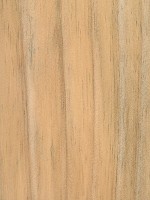 |
Common Name(s): Ocote Pine, Mexican Yellow Pine Scientific Name: Pinus oocarpa Distribution: Mexico and Central America; also grown on plantations Tree Size: 80-115 ft (24-35 m) tall, 2-3 ft (.6-1m) trunk diameter Average Dried Weight: 44 lbs/ft3 (700 kg/m3) Specific Gravity (Basic, 12% MC): .55, .70 Janka Hardness: 950 lbf (4,240 N) Modulus of Rupture: 14,720 lbf/in2 (101.5 MPa) Elastic Modulus: 2,209,000 lbf/in2 (15.23 GPa) Crushing Strength: 6,400 lbf/in2 (44.1 MPa) Shrinkage:Radial: 4.6%, Tangential: 7.5%, Volumetric: 12.3%, T/R Ratio: 1.6 |
Color/Appearance: Heartwood is light brown, sapwood is a paler yellowish white.
Grain/Texture: Straight grained with a medium, even texture.
Rot Resistance: The heartwood is rated as moderately durable to non-durable in regards to decay resistance.
Workability: Overall, Ocote Pine works fairly well with most tools, though the resin can gum up tools and clog sandpaper. Glues and finishes well.
Odor: Ocote Pine has a distinct, resinous odor while being worked.
Allergies/Toxicity: Working with pine has been reported to cause allergic skin reactions and/or asthma-like symptoms in some people. See the articles Wood Allergies and Toxicity and Wood Dust Safety for more information.
Pricing/Availability: Ocote Pine is widely grown on plantations, though it is certainly not as widely available as Radiata Pine. Lumber usage is usually for local needs or as wood pulp for papermaking. If available as dimensioned wood, prices are likely to be moderate for an imported timber.
Sustainability: This wood species is not listed in the CITES Appendices, and is reported by the IUCN as being a species of least concern.
Common Uses: Paper (pulpwood), veneer, plywood, boxes/crates, flooring, and construction lumber.
Comments: Ocote Pine is the national tree of Honduras, where the wood is used locally for a range of construction purposes.
- Austrian Pine (Pinus nigra)
- Caribbean Pine (Pinus caribaea)
- Eastern White Pine (Pinus strobus)
- Jack Pine (Pinus banksiana)
- Jeffrey Pine (Pinus jeffreyi)
- Khasi Pine (Pinus kesiya)
- Limber Pine (Pinus flexilis)
- Loblolly Pine (Pinus taeda)
- Lodgepole Pine (Pinus contorta)
- Longleaf Pine (Pinus palustris)
- Maritime Pine (Pinus pinaster)
- Patula Pine (Pinus patula)
- Pinyon Pine (Pinus edulis)
- Pitch Pine (Pinus rigida)
- Pond Pine (Pinus serotina)
- Ponderosa Pine (Pinus ponderosa)
- Radiata Pine (Pinus radiata)
- Red Pine (Pinus resinosa)
- Sand Pine (Pinus clausa)
- Scots Pine (Pinus sylvestris)
- Shortleaf Pine (Pinus echinata)
- Slash Pine (Pinus elliottii)
- Spruce Pine (Pinus glabra)
- Sugar Pine (Pinus lambertiana)
- Sumatran Pine (Pinus merkusii)
- Table Mountain Pine (Pinus pungens)
- Western White Pine (Pinus monticola)
- Virginia Pine (Pinus virginiana)
Scans/Pictures: There are currently no pictures of this exact wood species, but a similar species within the Pinus genus is being substituted (P. radiata). If you’d like to contribute a wood sample of this specific species to be scanned, (even small pieces of veneer can be sent), please use the contact form.





